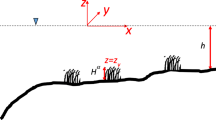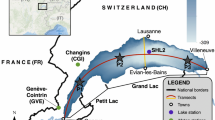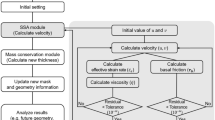Abstract
We develop a single-class ice and snow model embedded inside a 3D hydrodynamic model on unstructured grids and apply it to lake studies using highly variable mesh resolution. The model is able to reasonably capture the ice fields observed in both small and large lakes. For the first time, we attempt simulation of ice processes on very small scales (~ 1 m). Physically sound results are obtained at the expense of moderately increased computational cost, although more rigorous validation nearshore is needed due to lack of observation. We also outline challenges on developing new process-based capabilities for accurately simulating nearshore ice.















Similar content being viewed by others
Data availability
The datasets generated during and/or analyzed during the current study are available from the corresponding author on reasonable request.
References
Anderson J, Liu Y, Moghimi S, Zhang Y, Wu CH (to be submitted) Coastal upwelling and downwelling near the Keweenaw Peninsula, Lake Superior. J Geophys Res Oceans
Bai P, Wang J, Chu P, Hawley N, Fujisaki-Manome A, Kessler J, Lofgren BM, Beletsky D, Anderson EJ, Li Y (2020) Modeling the ice-attenuated waves in the Great Lakes. Ocean Dyn 70:991–1003
Benjamin SG, Smirnova TG, James EP et al (2022) Inland lake temperature initialization via coupled cycling with atmospheric data assimilation. Geosci Model Dev 15(17):6659–6676
Bouchat A, Hutter N, Chanut J, Dupont F, Dukhovskoy D, Garric G et al (2022) Sea ice rheology experiment (SIREx): 1. Scaling and statistical properties of sea-ice deformation fields. J Geophys Res Oceans 127:667. https://doi.org/10.1029/2021JC017667
Bouillon S, Fichefet T, Legat V, Madec G (2013) The elastic–viscous–plastic method revisited. Ocean Model 71:2–12. https://doi.org/10.1016/j.ocemod.2013.05.013
Bouillon S, Rampal P (2015) Presentation of the dynamical core of neXtSIM, a new sea ice model. Ocean Model 91:23–37. https://doi.org/10.1016/j.ocemod.2015.04.005
Fujisaki A, Wang J, Bai X, Leshkevich G, Lofgren B (2013) Model-simulated interannual variability of Lake Erie ice cover, circulation, and thermal structure in response to atmospheric forcing, 2003–2012. J Geophys Res Oceans 118:4286–4304. https://doi.org/10.1002/jgrc.20312
Hsieh Y-F (2011) Modeling ice cover and water temperature of Lake Mendota. PhD Thesis. Madison, Wisconsin. University of Wisconsin-Madison
Hunke EC, Lipscomb WH, Turner AK, Jeffery N, Elliott S CICE (2015) The Los Alamos sea ice model documentation and software user’s manual version 5.1, Tech. Rep., Los Alamos National Laboratory, LA-CC-06-012, https://github.com/CICE-Consortium/CICE-svn-trunk/blob/main/cicedoc/cicedoc.pdf (last access: 4 April 2022)
Hutter N, Losch M (2020) Feature-based comparison of sea ice deformation in lead-permitting sea ice simulations. Cryosphere 14:93–113. https://doi.org/10.5194/tc-14-93-2020
Kimmritz M, Losch M, Danilov S (2017) A comparison of viscous-plastic sea ice solvers with and without replacement pressure. Ocean Model 115:59–69. https://doi.org/10.1016/j.ocemod.2017.05.006
Kitchell JF (1992) Food web management : a case study of Lake Mendota, Lake Mendota Symposium, Madison, Wisconsin. Springer-Verlag, Berlin
Li Y, Beletsky D, Wang J, Austin JA, Kessler J, Fujisaki-Manome A, Bai P (2021) Modeling a large coastal upwelling event in Lake Superior. J Geophys Res Oceans 126. https://doi.org/10.1029/2020JC016512
Lin Y, Fujisaki-Manome A, Anderson EJ (2022) Simulating landfast ice in Lake Superior. J Mar Sci Eng 10:932
Matheson DH, Munawar M (1978) Lake Superior Basin and its development. JGreat Lakes Res 4(3–4):249–263. https://doi.org/10.1016/S0380-1330(78)72196-9
Mironov D, Heise E, Kourzeneva E, Ritter B, Schneider N, Terzhevik A (2010) Implementation of the lake parameterisation scheme FLake into the numerical weather prediction model COSMO. Boreal Environ Res 15:218–230
Parkinson CL, Washington WM (1979) A large-scale numerical model of sea ice. J Geophys Res 84(C1):311–337. https://doi.org/10.1029/JC084iC01p00311
Rampal P, Dansereau V, Olason E, Bouillon S, Williams T, Korosov A, Samaké A (2019) On the multi-fractal scaling properties of sea ice deformation. Cryosphere 13:2457–2474. https://doi.org/10.5194/tc-13-2457-2019
Smirnova TG, Brown JM, Benjamin SG, Kenyon JS (2016) Modifications to the rapid update cycle land surface model (RUC LSM) available in the weather research and forecasting (WRF) model. Mon Weather Rev 144:1851–1865
Titze D, Austin J (2016) Novel, direct observations of ice on Lake Superior during the high ice coverage of winter 2013–2014. J Great Lakes Res 42:997–1006
Wang Q, Danilov S, Sidorenko D, Timmermann R, Wekerle C, Wang X, Jung T, Schroter J (2014) The finite element sea ice-ocean model (FESOM) v.1.4: formulation of an ocean general circulation model. Geoscientic Model Dev 7(2):663–693. https://doi.org/10.5194/gmd-7-663-2014
West B, O’Connor D, Parno M, Krackow M, Polashenski C (2022) Bonded discrete element simulations of sea ice with non-local failure: applications to Nares Strait. J. Adv Model Earth Syst 14:e2021MS002614. https://doi.org/10.1029/2021MS002614
White B, Austin J, Matsumoto K (2012) A three dimensional model of Lake Superior with ice and biogeochemistry. J Great Lakes Res 30(1):61–71
Xiao C, Lofgren BM, Wang J, Chu PY (2016) Improving the lake scheme within a coupled WRF-lake model in the Laurentian Great Lakes. J Adv Model Earth Syst 8:1969–1985
Ye F, Zhang Y, Friedrichs M, Wang HV, Irby I, Shen J, Wang Z (2016) A 3D, cross-scale, baroclinic model with implicit vertical transport for the Upper Chesapeake Bay and its tributaries. Ocean Model 107:82–96. https://doi.org/10.1016/j.ocemod.2016.10.004
Zeng X, Zhao M, Dickinson RE (1998) Intercomparison of bulk aerodynamic algorithms for the computation of sea surface fluxes using TOGA COARE and TAO data. J Climatol 11:2628–2644
Zhang J, Hibler WD (1997) On an efficient numerical method for modelling sea ice dynamics. J Geophys Res 102:8691–8702
Zhang Y, Ateljevich E, Yu H-C, Wu C-H, Yu JCS (2015) A new vertical coordinate system for a 3D unstructured-grid model. Ocean Model 85:16–31
Zhang Y, Ye F, Stanev EV, Grashorn S (2016) Seamless cross-scale modeling with SCHISM. Ocean Model 102:64–81. https://doi.org/10.1016/j.ocemod.2016.05.002
Acknowledgements
Simulations used in this paper were conducted using the following computational facilities: (1) William & Mary Research Computing (URL: https://www.wm.edu/it/rc); (2) Texas Advanced Computing Center (TACC), The University of Texas at Austin.
Funding
This study is funded by NOAA (Grant number NA21NOS0080197).
Author information
Authors and Affiliations
Corresponding author
Ethics declarations
Competing interests
The authors declare no competing interests.
Supplemental Material
An animation of the modeled ice concentration shown in Fig. 8 can be found at http://ccrm.vims.edu/yinglong/TMP/anim_r61f_iceconc.avi (starting day is 1 Dec 2018). An animation of the modeled ice concentration shown in Fig. 15 can be found at http://ccrm.vims.edu/yinglong/TMP/anim_iceconc_r62c.avi.
Additional information
Responsible Editor :Jia Wang, Joanna Staneva
This article is part of the Topical Collection on the 12th International Workshop on Modeling the Ocean (IWMO), Ann Arbor, USA, 25 June – 1 July 2022
Rights and permissions
Springer Nature or its licensor (e.g. a society or other partner) holds exclusive rights to this article under a publishing agreement with the author(s) or other rightsholder(s); author self-archiving of the accepted manuscript version of this article is solely governed by the terms of such publishing agreement and applicable law.
About this article
Cite this article
Zhang, Y.J., Wu, C., Anderson, J. et al. Lake ice simulation using a 3D unstructured grid model. Ocean Dynamics 73, 219–230 (2023). https://doi.org/10.1007/s10236-023-01549-9
Received:
Accepted:
Published:
Issue Date:
DOI: https://doi.org/10.1007/s10236-023-01549-9




